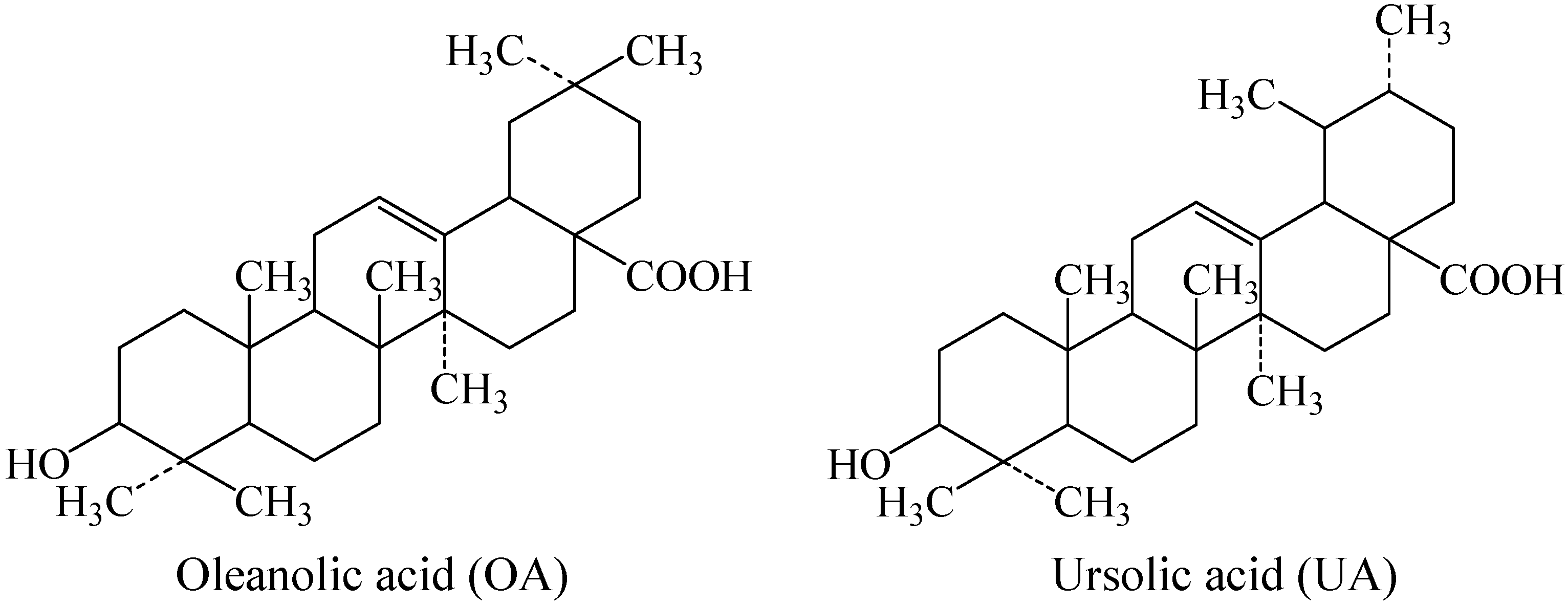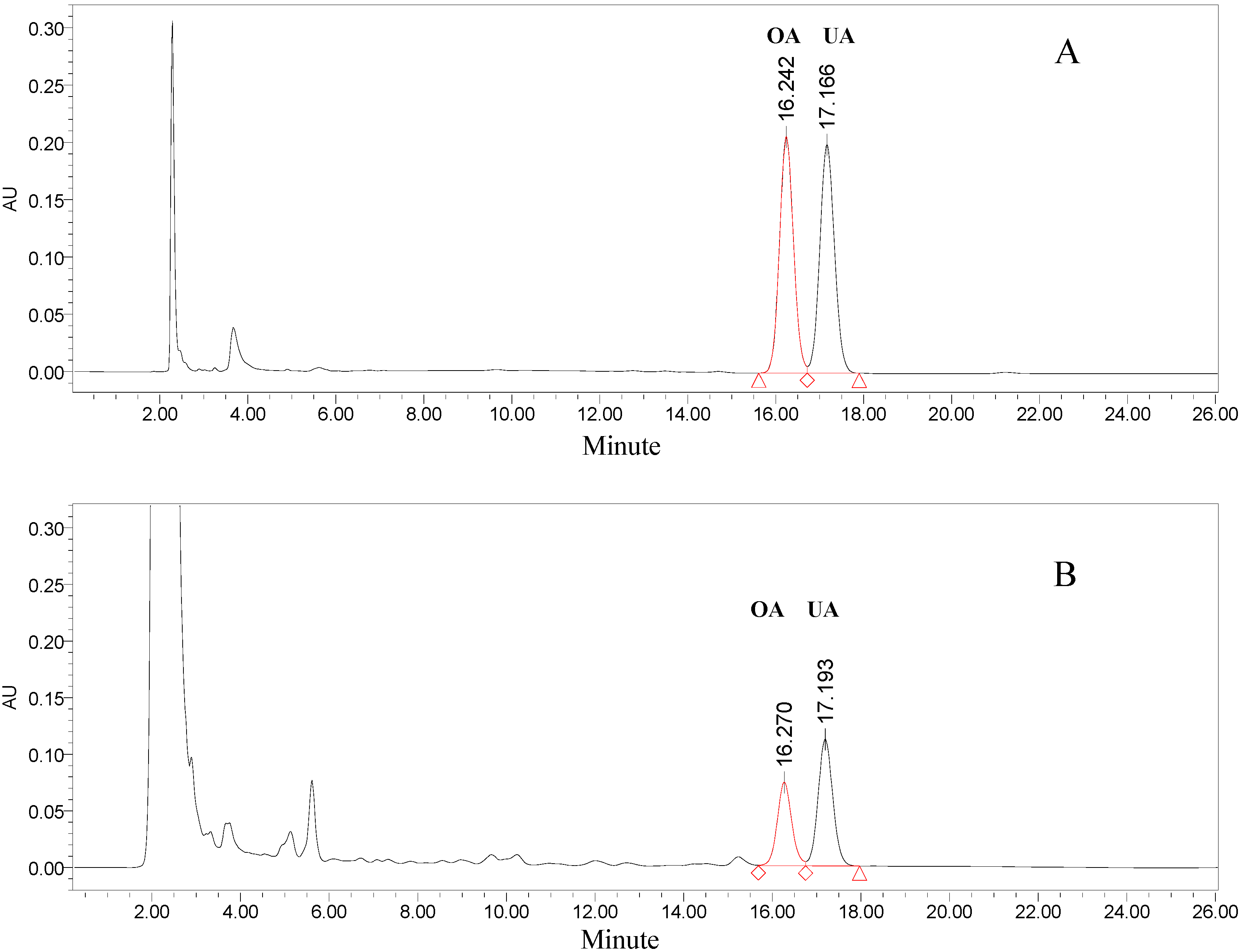Variation of Oleanolic and Ursolic Acid in the Flesh of Persimmon Fruit among Different Cultivars
Abstract
:1. Introduction

2. Results and Discussion
2.1. Evaluation of Fruit Quality
| Cultivars | W a (g) | VD b (cm) | HD c (cm) | FSI d | TSS e (ºBrix) | TA f (%) |
|---|---|---|---|---|---|---|
| Astringent persimmons | ||||||
| Boaidashuishi | 53.29 | 3.34 | 4.94 | 0.68 | 13.75 | 0.22 |
| Heixinshi | 94.73 | 5.05 | 5.61 | 0.90 | 11.11 | 0.37 |
| Heshi | 339.35 | 6.63 | 9.38 | 0.71 | 16.25 | 0.19 |
| Hiratanenashi | 113.94 | 4.18 | 6.29 | 0.66 | 15.64 | 0.19 |
| Hiro | 101.73 | 4.82 | 5.92 | 0.81 | 15.20 | 0.18 |
| Jianshi | 122.70 | 6.33 | 5.69 | 1.11 | 16.31 | 0.30 |
| Jinchengxiaoshi | 66.27 | 3.67 | 5.22 | 0.70 | 16.80 | 0.18 |
| Jinshi | 277.98 | 7.56 | 7.45 | 1.01 | 13.24 | 0.20 |
| Lantianshuishi | 148.58 | 5.69 | 6.48 | 0.88 | 14.26 | 0.26 |
| Mantianhong | 209.03 | 5.92 | 7.72 | 0.77 | 16.57 | 0.17 |
| Mendunshi | 81.66 | 5.05 | 5.45 | 0.93 | 18.15 | 0.12 |
| Miandanshi | 87.20 | 4.92 | 5.37 | 0.92 | 17.60 | 0.33 |
| Mimiguan | 48.28 | 4.41 | 4.33 | 1.02 | 15.48 | 0.38 |
| Naiyoushi | 141.28 | 5.17 | 6.47 | 0.80 | 13.45 | 0.24 |
| Ribenhongshi | 96.64 | 4.29 | 5.82 | 0.74 | 18.57 | 0.17 |
| Shagu NO.1 | 106.00 | 4.72 | 5.97 | 0.79 | 15.01 | 0.23 |
| Tianfushi | 123.34 | 4.96 | 6.22 | 0.80 | 14.40 | 0.14 |
| Tonewase | 215.10 | 5.57 | 7.95 | 0.70 | 17.50 | 0.20 |
| Xiaoercao | 35.72 | 3.19 | 4.30 | 0.74 | 12.38 | 0.24 |
| Xingyangbaheshi | 84.16 | 4.09 | 5.58 | 0.73 | 14.94 | 0.153 |
| Yichuanling | 63.28 | 4.42 | 4.72 | 0.94 | 15.20 | 0.14 |
| Yueshi | 153.82 | 4.69 | 5.79 | 0.81 | 14.90 | 0.27 |
| Zhaotianhong | 159.40 | 4.86 | 7.21 | 0.67 | 15.508 | 0.20 |
| Average | 127.11 | 4.94 | 6.08 | 0.82 | 15.31 | 0.22 |
| Non-astringent persimmons | ||||||
| Hanagosho | 111.90 | 5.16 | 6.39 | 0.81 | 21.58 | 0.09 |
| Jiro | 114.54 | 4.41 | 6.64 | 0.66 | 13.34 | 0.11 |
| Luotiantianshi | 57.02 | 4.01 | 4.78 | 0.84 | 15.65 | 0.14 |
| Matsumotowase | 59.20 | 4.21 | 5.21 | 0.81 | 17.19 | 0.15 |
| Nishimurawase | 115.58 | 4.57 | 6.75 | 0.68 | 16.39 | 0.21 |
| Okugosho | 100.68 | 4.56 | 6.16 | 0.74 | 18.16 | 0.27 |
| Suruga | 93.38 | 4.75 | 6.08 | 0.78 | 13.19 | 0.09 |
| Xianxitianshi | 110.40 | 4.56 | 6.49 | 0.70 | 15.33 | 0.14 |
| Zenjimaru | 135.65 | 5.29 | 6.43 | 0.82 | 14.10 | 0.21 |
| Average | 99.81 | 4.61 | 6.10 | 0.76 | 16.10 | 0.16 |
2.2. Identification of OA and UA in the Flesh of Persimmon Fruits by HPLC

2.3. OA and UA Contents in the Flesh of Persimmon Fruit
| Cultivar | OA | UA |
|---|---|---|
| Astringent persimmons | ||
| Boaidashuishi | 4.39 ± 0.05 | 11.18 ± 0.00 |
| Heixinshi | 20.44 ± 0.59 | 2.23 ± 0.15 |
| Heshi | 4.72 ± 0.29 | 12.88 ± 0.96 |
| Hiratanenashi | * | 1.44 ± 0.02 |
| Hiro | 1.89 ± 0.33 | 18.87 ± 1.03 |
| Jianshi | 3.87 ± 0.23 | 11.08 ± 0.30 |
| Jinchengxiaoshi | 1.70 ± 0.00 | 27.64 ± 0.01 |
| Jinshi | 0.57 ± 0.01 | 0.30 ± 0.00 |
| Lantianshuishi | 1.09 ± 0.04 | 16.83 ± 0.81 |
| Mantianhong | 5.40 ± 0.00 | 17.61 ± 0.20 |
| Mendunshi | 19.62 ± 1.51 | 0.23 ± 0.01 |
| Miandanshi | 4.88 ± 0.18 | 15.30 ± 0.24 |
| Mimiguan | 0.59 ± 0.03 | 3.74 ± 0.09 |
| Naiyoushi | 0.16 ± 0.01 | 1.06 ± 0.04 |
| Ribenhongshi | 88.57 ± 1.91 | * |
| Shagu NO.1 | 4.28 ± 0.99 | 14.89 ± 1.13 |
| Tianfushi | 1.57 ± 0.01 | 3.03 ± 0.02 |
| Tonewase | 46.42 ± 0.32 | 1.79 ± 0.02 |
| Xiaoercao | 18.94 ± 0.38 | 2.12 ± 0.09 |
| Xingyangbaheshi | 1.16 ± 0.12 | 2.00 ± 0.03 |
| Yichuanling | 5.60 ± 0.33 | 14.67 ± 0.57 |
| Yueshi | 1.15 ± 0.01 | 2.82 ± 0.05 |
| Zhaotianhong | 0.74 ± 0.10 | 22.74 ± 0.04 |
| Average | 10.81 | 9.29 |
| Non-astringent persimmons | ||
| Hanagosho | 12.33 ± 0.43 | 2.23 ± 0.03 |
| Jiro | 26.43 ± 0.24 | 0.24 ± 0.03 |
| Luotiantianshi | 22.90 ± 0.20 | 7.09 ± 0.02 |
| Matsumotowase | 20.85 ± 0.14 | * |
| Nishimurawase | 12.80 ± 0.12 | 0.24 ± 0.01 |
| Okugosho | 1.31 ± 0.06 | 1.47 ± 0.02 |
| Suruga | 1.24 ± 0.01 | 1.81 ± 0.03 |
| Xianxitianshi | 15.37 ± 0.57 | 1.03 ± 0.33 |
| Zenjimaru | 5.68 ± 0.55 | 12.23 ± 1.18 |
| Average | 13.21 | 3.29 |
3. Experimental
3.1. Materials and Reagents
3.2. Preparation of Standard Solution and Crude Extract
3.3. HPLC Analysis of OA and UA
3.4. Statistical Analysis
4. Conclusions
Acknowledgements
- Sample Availability: Samples of the compounds are available from the authors.
References
- Thuong, P.; Lee, C.H.; Dao, T.T.; Nguyen, P.H.; Kim, W.G.; Lee, S.J.; Oh, W.K. Triterpenoids from the leaves of Diospyros kaki (persimmon) and their inhibitory effects on protein tyrosine phosphatase 1B. J. Nat. Prod. 2008, 71, 1775–1778. [Google Scholar]
- Celik, A.; Ercisli, S. Persimmon cv. Hachiya (Diospyros kaki Thunb.) fruit: Some physical, chemical and nutritional properties. Int. J. Food Sci. Nutr. 2007, 18, 1–8. [Google Scholar]
- Del Bubba, M.; Giordani, E.; Pippucci, L.; Cincinelli, A.; Checchini, L.; Galvan, P. Changes in tannins, ascorbic acid and sugar contents in astringent persimmons during on-tree growth and ripening and in response to different postharvest treatments. J. Food Compos. Anal. 2009, 22, 668–677. [Google Scholar] [CrossRef]
- Ebert, G.; Gross, J. Carotenoid changes in the peel of ripening persimmon (Diospyros kaki) cv. Triumph. Phytochemistry 1985, 24, 29–32. [Google Scholar]
- Gorinstein, S. Comparative content of total polyphenols and dietary fiber in tropical fruits and persimmon. J. Nutr. Biochem. 1999, 10, 367–371. [Google Scholar] [CrossRef]
- Liu, Y.J.; Xie, J.L. Ursolate compounds from fruit of Diospyros kaki L. f. (in Chinese). J. Plant Resour. Environ. 2001, 10, 1–3. [Google Scholar]
- Ma, Q.; Qin, T.; Zhang, Q. Analysis of ingredient in persimmon frost (in Chinese). Food Res. Dev. 2005, 26, 143–145. [Google Scholar]
- Matsuo, T.; Ito, S. The chemical structure of Kaki-tannin from immature fruit of the persimmon (Diospyros kaki L.) (in Japanese). Agr. Biol. Chem. 1978, 42, 1637–1643. [Google Scholar] [CrossRef]
- Yuan, B.; Xu, H.L.; Leng, S.P. Content and chemical composition of carotenoids in persimmon fruit (in Chinese). Chin. Agr. Sci. Bull. 2006, 22, 277–280. [Google Scholar]
- Zheng, Y.M.; Xu, X.Y.; Yang, Y.H.; Fu, S.Q. Determination of hyperoside and oleanolic acid in Diospyos kaki by HPLC (in Chinese). J. Pharm. Pract. 2005, 23, 163–165. [Google Scholar]
- Lin, J.F.; Lin, H.T.; Xie, L.H.; Lin, Q.Y.; Chen, S.J.; Zhao, Y.F. A Review of chemical onstituents, medicinal function, clinical application of persimmon leaves and their development and utilization (in Chinese). Food Fermentation Ind. 2005, 31, 90–96. [Google Scholar]
- Vasconcelos, M.A.; Royo, V.A.; Ferreira, D.S.; Crotti, A.E.; Andrade, S.M.L.; Carvalho, J.C.; Bastos, J.K.; Cunha, W.R. In vivo analgesic and anti-inflammatory activities of ursolic acid and oleanoic acid from Miconia albicans (Melastomataceae). Z.Naturforsch. 2006, 61, 477–482. [Google Scholar]
- Saraswat, B.; Visen, P.K.S.; Dayal, R.; Agarwal, D.P.; Patnaik, G.K. Protective action of ursolic acid against chemical induced hepatotoxicity in rats. Indian J. Pharmacol. 1996, 28, 232–239. [Google Scholar]
- Rodriguez, J.A.; Astudillo, L.; Schmeda-Hirschmann, G. Oleanolic acid promotes healing of acetic acid-induced chronic gastric lesions in rats. Pharmacol. Res. 2003, 48, 291–294. [Google Scholar] [CrossRef]
- Somova, L.O.; Nadar, A.; Rammanan, P.; Shode, F.O. Cardiovascular, antihyperlipidemic and antioxidant effects of oleanolic and ursolic acids in experimental hypertension. Phytomedicine 2003, 10, 115–121. [Google Scholar] [CrossRef]
- Hsu, H.Y.; Yang, J.J.; Lin, C.C. Effects of oleanolic acid and ursolic acid on inhibiting tumor growth and enhancing the recovery of hematopoietic system postirradiation in mice. Cancer Lett. 1997, 111, 7–13. [Google Scholar] [CrossRef]
- Kashiwada, Y.; Nagao, T.; Hashimoto, A.; Ikeshiro, Y.; Okabe, H.; Cosentino, L.M.; Lee, K.H. Anti-AIDS agents 38. Anti-HIV activity of 3-O-acyl ursolic acid derivatives. J. Nat. Prod. 2000, 63, 1619–1622. [Google Scholar]
- Raphael, T.J.; Kuttan, G. Effect of naturally occurring triterpenoids glycyrrhizic acid, ursolic acid, oleanolic acid and nomilin on the immune system. Phytomedicine 2003, 10, 483–489. [Google Scholar]
- Cui, T.; Li, J.Z.; Kayahara, H.; Ma, L.G.; Wu, L.X.; Nakamura, K. Quantification of the polyphenols and triterpene acids in Chinese hawthorn fruit by high-performance liquid chromatography. J. Agric. Food Chem. 2006, 54, 4574–4581. [Google Scholar] [CrossRef]
- Guo, S.; Duan, J.; Tang, Y.; Su, S.; Shang, E.; Ni, S.; Qian, D. High-performance liquid chromatography-Two wavelength detection of triterpenoid acids from the fruits of Ziziphus jujuba containing various cultivars in different regions and classification using chemometric analysis. J. Pharm. Biomed. Anal. 2009, 49, 1296–1302. [Google Scholar] [CrossRef]
- Zhou, C.H.; Chen, K.S.; Sun, C.D.; Chen, Q.J.; Zhang, W.S.; Li, X. Determination of oleanolic acid, ursolic acid, and amygdalin in the flower of Eriobotrya japonica Lindl. by HPLC. Biomed.Chromatogr. 2007, 21, 755–761. [Google Scholar] [CrossRef]
© 2010 by the authors; licensee MDPI, Basel, Switzerland. This article is an open access article distributed under the terms and conditions of the Creative Commons Attribution license (http://creativecommons.org/licenses/by/3.0/).
Share and Cite
Zhou, C.; Sheng, Y.; Zhao, D.; Wang, Z.; Tao, J. Variation of Oleanolic and Ursolic Acid in the Flesh of Persimmon Fruit among Different Cultivars. Molecules 2010, 15, 6580-6587. https://doi.org/10.3390/molecules15096580
Zhou C, Sheng Y, Zhao D, Wang Z, Tao J. Variation of Oleanolic and Ursolic Acid in the Flesh of Persimmon Fruit among Different Cultivars. Molecules. 2010; 15(9):6580-6587. https://doi.org/10.3390/molecules15096580
Chicago/Turabian StyleZhou, Chunhua, Yanle Sheng, Daqiu Zhao, Zhiqin Wang, and Jun Tao. 2010. "Variation of Oleanolic and Ursolic Acid in the Flesh of Persimmon Fruit among Different Cultivars" Molecules 15, no. 9: 6580-6587. https://doi.org/10.3390/molecules15096580
APA StyleZhou, C., Sheng, Y., Zhao, D., Wang, Z., & Tao, J. (2010). Variation of Oleanolic and Ursolic Acid in the Flesh of Persimmon Fruit among Different Cultivars. Molecules, 15(9), 6580-6587. https://doi.org/10.3390/molecules15096580




